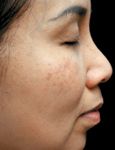- Case-Based Roundtable
- General Dermatology
- Eczema
- Chronic Hand Eczema
- Alopecia
- Aesthetics
- Vitiligo
- COVID-19
- Actinic Keratosis
- Precision Medicine and Biologics
- Rare Disease
- Wound Care
- Rosacea
- Psoriasis
- Psoriatic Arthritis
- Atopic Dermatitis
- Melasma
- NP and PA
- Skin Cancer
- Hidradenitis Suppurativa
- Drug Watch
- Pigmentary Disorders
- Acne
- Pediatric Dermatology
- Practice Management
- Prurigo Nodularis
- Buy-and-Bill
Article
East Asian skin
East Asian skin tends to be thicker, with more melanin than Caucasian skin. Dermatologists should take these qualities and other issues into account when treating these patients.

Key Points

According to Jessica Wu, M.D., an Asian dermatologist in Los Angeles, Asians, a fast-growing minority group in the United States, have specific skin and cultural issues that affect their dermatologic treatment outcomes.

Common conditions
One condition that is more prevalent among East Asians is nevus of Ota, which often appears at birth or during childhood.
The condition presents as slate blue-colored patches in a unilateral, trigeminal nerve distribution on the face. Dr. Wu typically treats nevus of Ota, which often involves the conjunctiva, with Q-switched lasers.
"In terms of adults and acquired conditions, the two most common that I see among my East Asian patients are melasma and Hori's nevus, or acquired bilateral nevus of Ota-like macules. This is a condition that often occurs in conjunction with melasma. It is acquired, without conjunctival pigmentation. Histologically, we see an increase in dermal melanocytes," Dr. Wu says.
Dr. Wu treats the condition as she would melasma in Caucasians, with topical skin lighteners, sunscreen, chemical peels and laser. One recent study from Hong Kong demonstrated successful treatment of Hori's nevus with a combination of Q-switched 532 nm Nd:YAG and the Q-switched 1064 nm Nd:YAG laser. The idea, according to Dr. Wu, is to reduce the energy in order to minimize skin injury.
"I warn my Asian patients that we may have to treat them with more sessions than we would Caucasian patients," she says.
Dr. Wu says her favorite approach to treating melasma in East Asian patients is with the trichloroacetic acid (TCA) chemical peel. She uses 20 percent to 35 percent strength TCA solution. And she only performs the peel or laser procedures if patients promise that they will use sunscreen and agree to prepare their skin for at least a month with a hydroquinone and tretinoin cream.
"Typically, I use Tri-Luma (Galderma) or a compounded fading cream of hydroquinone 5 percent and tretinoin 0.05 percent," she says. "With East Asian skin, we also have to be careful because some of the bleaching creams can cause irritation and, therefore, stimulate hyperpigmentation. So, I educate these patients about first using the creams every other day or less to ease into the therapy. I have also seen Asian patients develop hyperpigmentation from using tretinoin- or retinoid-containing products."
Other special considerations
Before performing chemical peels or laser treatments on Asian patients, Dr. Wu will often do a test spot to make sure a patient's skin is not going to develop a vigorous postinflammatory response.
In addition to melasma, lentigines and dermatosis papulosis nigra (DPN) are common skin conditions among East Asians.
She often treats these conditions with topical bleaching creams, chemical peels and intense pulsed light. Fractionated laser treatments also have been successful.





